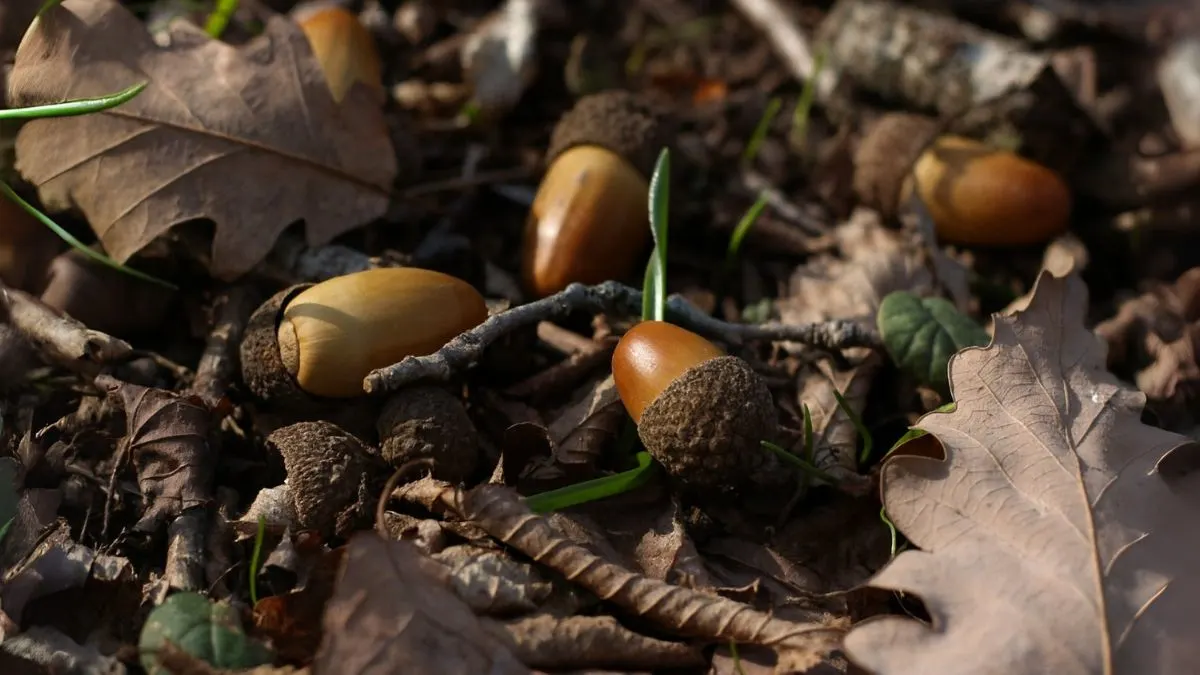Walk through a park or your backyard right now, and you may notice the ground carpeted with acorns. While these little nuts are a valuable food source for wildlife, many people wonder why some years oak trees seem to “rain” acorns more than others.
This phenomenon is not random. Oak trees respond to environmental cues, such as climate temperatures and rainfall amounts, as well as natural cycles that affect flower and seed production. Add in influences like hungry squirrels and you’ll understand why this year might feel like an acorn overload.
Understanding Acorn Production

- The Role of Flowers: Acorns begin as flowers in the spring. If there’s a late spring frost, it can kill off flowers, reducing the number of acorns later that year. However, when conditions are favorable, more flowers survive, and by autumn, oak trees may release thousands of acorns.
- Climate Influence: Scientists note that acorn production is heavily tied to climate temperatures and rainfall amounts. Years with steady rainfall and mild temperatures create ideal conditions for oak trees to thrive and produce more seeds. Conversely, drought or heat stress can trigger “survival mode,” leading the tree to push out excess acorns.
Why So Many Acorns This Year?
Oak trees often follow a “boom-and-bust” cycle known as masting. Some years produce few acorns, while others see a bumper crop. Here’s why:
- Extreme weather conditions: Oaks under stress, whether from drought, storms, or temperature fluctuations, may produce a massive acorn crop as a survival mechanism.
- Wildlife interaction: Hungry squirrels and birds play a role too. They eat many of the acorns, but they also bury them, helping new oaks sprout in the wild.
- Natural rhythm: Oaks evolved to overwhelm seed predators by producing so many acorns that not all can be eaten, ensuring the species’ survival.
Also Read: Fairy Bells in Your Garden? Discover the Magic of the Wood Sorrel Plant
Impact on Wildlife
For animals like deer, jays, chipmunks, and especially hungry squirrels, acorns are a feast. These wildlife populations often expand in years of high acorn production, but they can also decline sharply in lean years.
This creates ripple effects across ecosystems — predators like owls and foxes may thrive when prey animals multiply after a big acorn season.
Challenges for Homeowners
While acorns benefit wildlife, homeowners may see them as a nuisance:
- Lawns littered with acorns can be difficult to maintain.
- Excess acorns may attract too many animals, including pests.
- Walking on acorn-covered driveways can even be a slipping hazard.
Practical steps include raking regularly, using leaf vacuums, or composting acorns into garden mulch.
Personal Experience with Acorn Drop
Last fall, I watched as a massive oak near my home in Toronto seemed to shed acorns by the bucketful. Squirrels were everywhere, collecting, burying, and sometimes squabbling over their treasure. While it meant extra raking for me, I realized this was part of the oak’s natural cycle.
By spring, I noticed tiny oak saplings popping up across the yard — living proof of how these cycles help forests regenerate, even in suburban neighborhoods.
Key Reasons for Heavy Acorn Drop
Factor |
Effect on Acorn Production |
If there’s a late spring frost, it can kill off flowers |
Reduces acorns that year |
Climate temperatures and rainfall amounts |
Favorable conditions = more flowers and seeds |
Hungry squirrels |
Consume and disperse acorns |
Due to extreme weather conditions |
Oaks push out more acorns under stress |
Also Read: Bellis Flowers: The Low-Maintenance Bloom That Keeps Coming Back
Caring for Oak Trees During Acorn Season
- Watering: In dry years, watering mature oaks can reduce stress and prevent premature acorn drops.
- Mulching: A natural mulch around the base helps retain soil moisture.
- Pruning: Proper pruning encourages healthier flowering and acorn cycles.
- Observation: Keep track of weather patterns. Years with erratic rainfall or sudden frosts often predict unusual acorn behavior.
The sight of thousands of acorns under oak trees might feel overwhelming, but it’s a fascinating glimpse into nature’s resilience. If there’s a late spring frost, it can kill off flowers, but favorable climate temperatures and rainfall amounts encourage bumper crops. Oaks also react due to extreme weather conditions, releasing more acorns to ensure survival. And of course, hungry squirrels play their part, scattering seeds that grow into the oak forests of tomorrow.
So, next time you’re raking up piles of acorns, remember: you’re witnessing an ancient survival strategy in action, one that sustains wildlife and shapes ecosystems worldwide.






